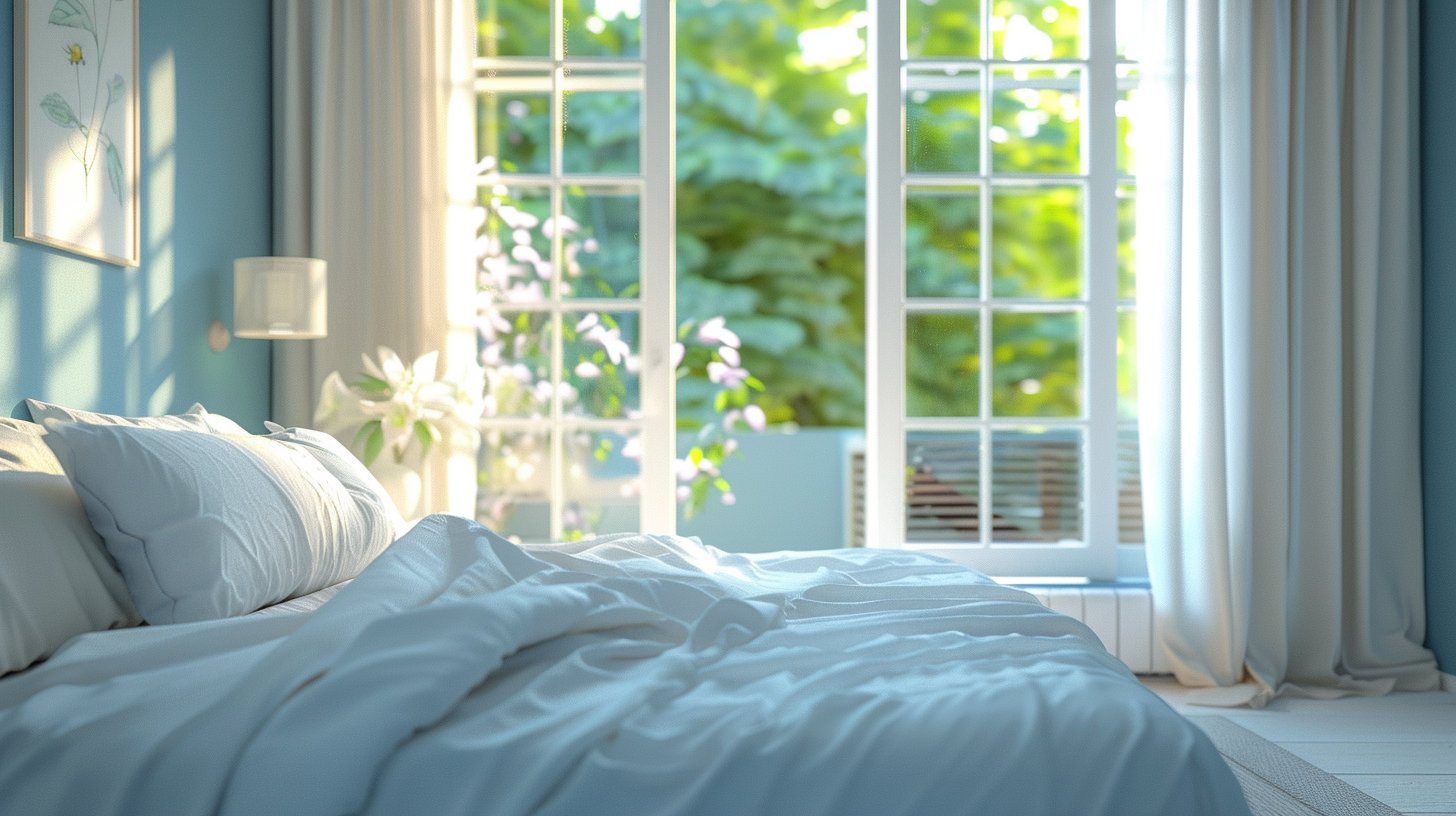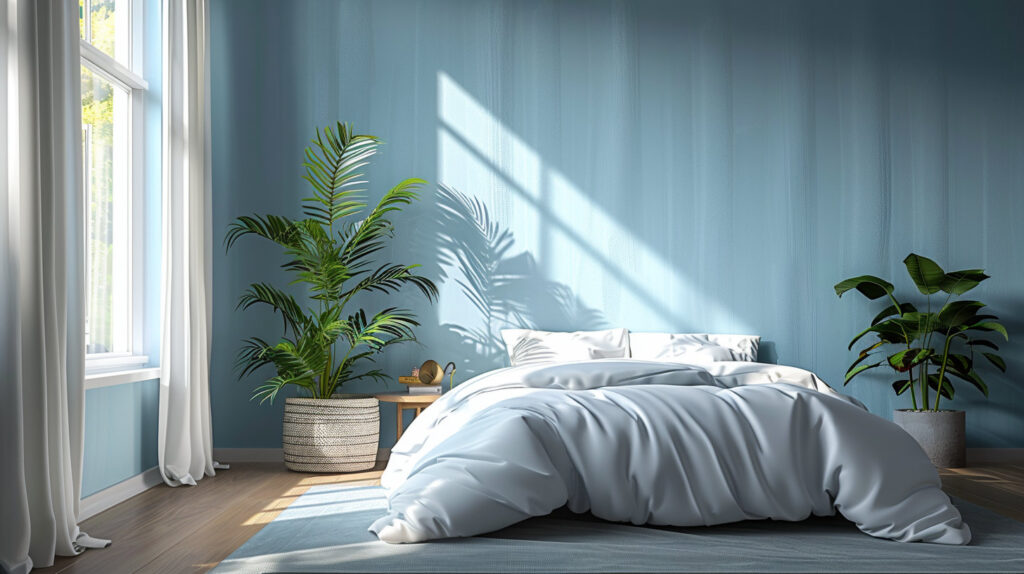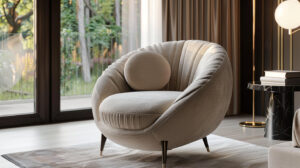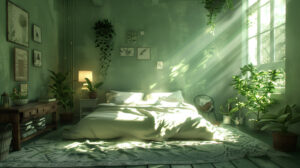
Are you tossing and turning at night, desperately seeking that elusive good night’s sleep? The solution might be as simple as giving your bedroom a blue makeover. That’s right – blue bedrooms are more than just a design trend; they’re a scientifically-backed way to enhance your sleep quality. Let’s dive into the calming world of blue and discover how it can revolutionize your rest.
Introduction to Blue Bedrooms and Sleep Quality

Picture this: you walk into your bedroom after a long, stressful day. The soft, cool hues of blue walls greet you, instantly melting away the tension in your shoulders. You sink into your bed, surrounded by soothing shades of azure and cerulean. As you close your eyes, you feel a wave of tranquility wash over you. This is the magic of a blue bedroom.
Blue bedrooms have gained popularity not just for their aesthetic appeal, but for their remarkable ability to transform sleep quality. It’s not just interior designers singing their praises – scientists are backing up these claims with hard data. Studies show that the color blue can create a calming and serene atmosphere, which is essential for a good night’s rest.
But why blue? What makes this color so special when it comes to sleep? And how can you harness its power to improve your own sleep quality? Stick with me, and we’ll explore all this and more. By the end of this article, you’ll be itching to grab a paintbrush and give your bedroom the blue transformation it deserves.
The Science Behind Blue and Sleep
How Colors Affect Sleep
Before we dive into the specifics of blue, let’s talk about color psychology. You might be surprised to learn that the colors around us can significantly impact our mood, behavior, and even our physiological responses. It’s not just about what looks pretty – our brains react to different colors in distinct ways.
When it comes to sleep, some colors are more conducive to rest than others. Red, for instance, is associated with energy and excitement – not exactly what you want when you’re trying to wind down. On the other hand, cool colors like blue have been shown to have a calming effect on the mind and body.
The Impact of Blue on the Mind and Body
So, what’s so special about blue? Well, it turns out that our brains are wired to associate blue with calmness and tranquility. When we see blue, our bodies respond by producing more melatonin, the hormone responsible for regulating our sleep-wake cycles.
But don’t just take my word for it. A study conducted by Travelodge found that people who slept in blue rooms got an average of 7 hours and 52 minutes of sleep per night – more than any other color! The same study showed that blue bedroom dwellers woke up feeling happy and positive.
The Calming Effect of Blue
Ever wonder why you feel so relaxed when you look at the ocean or a clear blue sky? It’s not just the vacation vibes – blue has a physiological effect on our bodies. It can lower heart rate and blood pressure, reducing overall stress levels.
Compared to other calming colors like green or lavender, blue takes the crown when it comes to promoting restfulness. While green might remind you of nature and lavender of soothing aromatherapy, blue has the unique ability to make you feel like you’re in a cocoon of calm, protected from the stresses of the outside world.
Designing a Blue Bedroom for Optimal Sleep
Now that we’re all on board the blue bedroom train, let’s talk about how to actually implement this in your own space. Don’t worry – you don’t need to be an interior designer to create a sleep-inducing blue oasis.
Choosing the Right Shade of Blue
When it comes to blue bedrooms, not all shades are created equal. Light blues can create an airy, expansive feeling, perfect for smaller rooms or those who prefer a brighter space. Think of the soft blue of a robin’s egg or the pale azure of a clear summer sky.
On the other hand, darker blues can create a cozy, cocoon-like atmosphere that some find incredibly soothing. Navy or indigo can be particularly effective in larger rooms, creating a sense of intimacy and warmth.
Pro tip: Before committing to a color, try painting a few swatches on your wall and observe how they look at different times of day. The way the light hits the color can dramatically change its appearance and effect.
Blue Bedroom Decor Ideas
Painting your walls is just the beginning. Here are some ways to incorporate blue into your bedroom decor:
Blue bedding: Invest in some high-quality blue sheets or a plush blue comforter.
Blue curtains: Not ready to commit to blue walls? Blue curtains can provide a similar effect.
Blue accents: Throw pillows, rugs, or artwork in shades of blue can add pops of calming color.
Remember, you don’t have to go all-out blue. Even small touches of blue can have a significant impact on the overall feel of your room.
Combining Blue with Other Colors
While a monochromatic blue room can be stunning, don’t be afraid to mix it up. Blue pairs beautifully with a variety of colors:
White: For a classic, crisp look
Gray: To create depth and sophistication
Yellow: For a cheerful contrast (in small doses)
Green: To bring in elements of nature
The key is balance. You want blue to be the star of the show, with other colors playing supporting roles.
Benefits of Blue Bedrooms for Sleep Quality
Now that we’ve covered the ‘how’, let’s dive deeper into the ‘why’. The benefits of blue bedrooms extend far beyond just looking pretty.
Improved Sleep Patterns
Remember that melatonin we talked about earlier? By promoting its production, blue bedrooms can help regulate your sleep cycles. This means you’re more likely to fall asleep faster and stay asleep longer.
Many blue bedroom converts report experiencing deeper, more restful sleep. One such convert, Sarah from Seattle, told me, “Since painting my bedroom a soft shade of blue, I’ve noticed I wake up feeling more refreshed. It’s like my sleep is more efficient now.”
Enhanced Relaxation and Stress Relief
In our fast-paced world, finding ways to de-stress is crucial. A blue bedroom can serve as your personal oasis of calm. The soothing effect of blue can help lower your heart rate and blood pressure, making it easier to shed the stresses of the day.
Think of your blue bedroom as a signal to your brain that it’s time to relax. Over time, just stepping into your blue room can trigger a pavlovian response of calmness.
Better Mental Health and Mood
The connection between sleep quality and mental health is well-established. Poor sleep can exacerbate symptoms of depression and anxiety, while good sleep can help alleviate them. By improving your sleep quality, a blue bedroom can indirectly contribute to better overall mental health.
Moreover, waking up in a blue room can set a positive tone for your day. Blue is associated with feelings of serenity and confidence – not a bad way to start your morning!
Practical Tips for Implementing Blue in Your Bedroom
Ready to blue-ify your bedroom? Here are some practical tips to get you started:
Budget-Friendly Blue Bedroom Ideas
Don’t worry – you don’t need to break the bank to reap the benefits of a blue bedroom. Here are some wallet-friendly ideas:
Use blue pillowcases or a blue throw blanket
Hang blue curtains or blinds
Paint one accent wall blue instead of the entire room
DIY some blue wall art (abstract blue brush strokes on canvas can look quite chic!)
Remember, even small touches of blue can make a difference. Start small and see how it affects your sleep before committing to a full room makeover.
Expert Advice on Blue Bedroom Design
I reached out to Sarah Johnson, a sleep environment specialist, for some pro tips. Here’s what she had to say:
“When designing a blue bedroom for optimal sleep, consider the intensity of the blue. Too bright can be stimulating, while too dark might feel gloomy. A soft, muted blue often works best. Also, don’t forget about texture – a mix of smooth and plush textures can enhance the calming effect of blue.”
Sarah also warned against a common mistake: going overboard with blue. “While blue is great for sleep, too much of any one color can feel overwhelming. Balance is key,” she advised.
FAQs About Blue Bedrooms and Sleep Quality
How does the color blue affect sleep quality?
Blue helps create a calming environment by reducing stress and promoting melatonin production. This can lead to faster sleep onset and more restful sleep throughout the night.
Are dark blues better than light blues for bedrooms?
Both have their merits. Dark blues create a cozy, cocoon-like atmosphere, while light blues are airy and serene. The best choice depends on your personal preference and the size and lighting of your room.
Can I combine blue with other colors in my bedroom?
Absolutely! Blue pairs well with many colors. White, grey, and soft pastels are popular choices. The key is to let blue be the dominant color while using others as accents.
How can I add blue to my bedroom without repainting?
There are many ways to incorporate blue without touching a paintbrush. Try blue bedding, curtains, rugs, or decorative accents like throw pillows or artwork.
Is there scientific evidence supporting blue for better sleep?
Yes, several studies have shown that blue can improve sleep quality and reduce stress. For example, a Travelodge study found that people sleeping in blue rooms got more sleep on average than those sleeping in rooms of other colors.
Can blue bedrooms help with insomnia?
While not a cure for insomnia, blue bedrooms can create an environment more conducive to sleep. The calming effects of blue may help those with insomnia relax and fall asleep more easily.
How long does it take to see the effects of a blue bedroom on sleep quality?
This can vary from person to person. Some people report immediate improvements, while for others it might take a few weeks to adjust and notice changes in their sleep patterns.
Summary
Transforming your bedroom with shades of blue can be a game-changer for your sleep quality. The calming effects of blue, combined with thoughtful design, can create a serene and restful environment that promotes better sleep and improved overall well-being.
Whether you opt for light blue walls that remind you of a clear sky, or deep blue accents that evoke the tranquility of the ocean depths, incorporating this color into your bedroom can lead to nights of better sleep and mornings of renewed energy.
Remember, the journey to better sleep doesn’t have to be complicated or expensive. Even small touches of blue can make a significant difference. So why not give it a try? Your future well-rested self might just thank you.
Ready to experience into the world of blue bedrooms? Start small, experiment with different shades, and most importantly, pay attention to how you feel. Sweet (blue) dreams!




